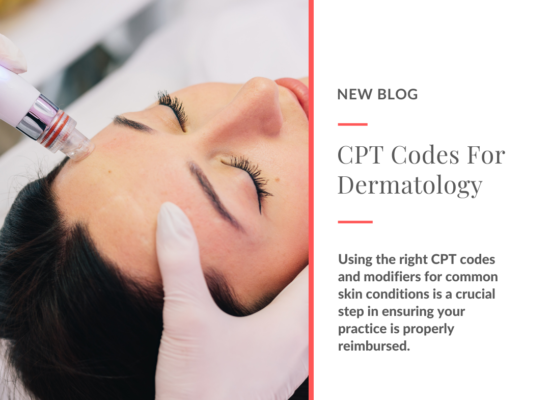Skin is the largest organ of the human body, and there’s an incredibly long list of diseases and conditions that can affect it. As a result, dermatology medical billing is highly complex and nuanced, often requiring staff to become experts on specific dermatology CPT codes and modifiers, which is no easy task.
To add to the challenge, billing processes often change, codes get updated or retired, and new modifiers get added to the list, which can make it difficult to accurately manage your medical billing. Inaccurate billing leads to more claims being rejected, and time and effort wasted on adjusting claims, which ultimately affects your revenue potential and leads to financial inefficiency.
If you want to try and stay ahead of the claims on your own, it can be very helpful to have a “Cheat Sheet” of frequently used dermatology CPT codes for your billing department to easily reference while filling in information for insurance providers. There are hundreds of codes but your staff can benefit from having a list of 20 or more of the most commonly used CPT codes. You can use our list below as a guide, and add more as necessary.
The above list is by no means exhaustive and will need to be updated as necessary. But a dermatology CPT codes cheat sheet can be a handy tool to help your staff identify the correct codes and apply them properly. It is advisable to also include the most commonly used modifiers in your office, depending on which specific services you commonly provide and specialize in.
Our goal at Derm Care Billing Consultants is to help clients cut through the complexity of dermatology billing and establish the best practices to ensure your codes and modifiers are accurate. Dermatology practices can benefit from outsourcing their billing to a specialist like Derm Care to efficiently manage their medical billing, improve their clean claims rate, and stay abreast of updates to codes and modifiers.
By outsourcing your medical billing, dermatologists can focus on their work, instead of getting bogged down with claims and denials. Your billing staff can save time and energy which leads to increased staff satisfaction and productivity; dermatologists can ensure they are meeting compliance standards; patients benefit from efficient and accurate treatment and bill processing; and ultimately your practice will realize its true revenue potential.
Contact us today to learn more about how Derm Care can streamline your billing practices and increase billing efficiency and success.





